Update (3/1): SDOT has confirmed speed limit changes on Aurora and other corridors is expected in 2021 pending approval from WSDOT. The post has been updated below with comment from the department.
Late last year, the Seattle Department of Transportation proposed a plan to reduce speeds on most of the highways within the city of Seattle that fall under the jurisdiction of the state of Washington. The proposal, obtained by Seattle Bike Blog via a records request, if fully implemented, would ultimately leave very few remaining stretches of highway through the city with a speed limit above 30 mile per hour.
This move follows an announcement in fall of 2019 that the City of Seattle would be moving to adjust speed limits on most arterial streets to 25 mph. As of January, the department said that nearly 75% of arterials are currently posted as 25 mph. But WSDOT corridors like Aurora Ave and former WSDOT corridors like Rainier Ave see a huge share of Seattle’s serious traffic injuries and fatalities. SDOT’s proposal to WSDOT notes there were 53 serious injuries or fatalities on Aurora Avenue resulting from collisions between 2015 and 2019 and 595 injuries that weren’t determined to be severe in the same timeframe. Aurora Ave remains a public health crisis.
The first phase of speed limit reductions would implement a 30 mph speed limit on Aurora Ave N north of Green Lake. Currently that stretch has segments where the limit is 40 mph and segments where it’s 35. The speed limit along 145th St would be lowered to match this speed, as well as the northern segment of Lake City Way. Between 115th and 130th on Lake City Way, in the heart of Lake City, the limit would drop to 25mph matching Seattle’s other arterials. Sand Point Way south of NE 65th St would drop from 35 to 30 mph; north of there SDOT has already implemented a 25 mph limit.
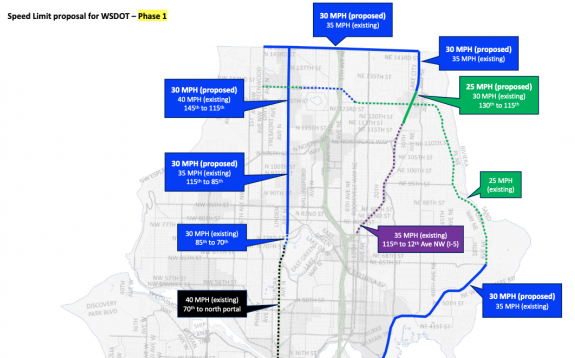
South of downtown, East Marginal Way between Spokane Street and the 1st Ave S bridge would go from 35 to 30 mph and a very short segment of Highland Park Way/SR-99 over 1st Ave S would drop from 35 mph to 25 mph.
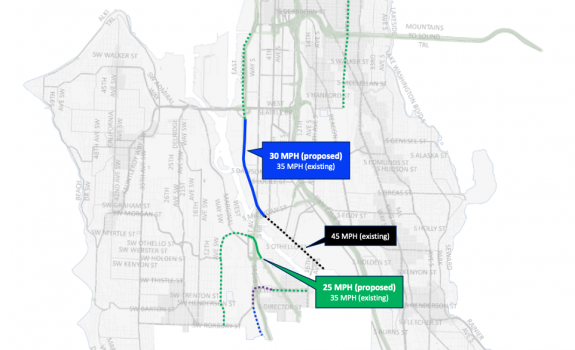
The second phase would lower speeds on the remaining stretch of Aurora south of Green Lake from 40 mph to 35 mph. This is the stretch of Aurora that SDOT’s data shows the most people currently drive at speeds significantly above the limit. The remainder of Lake City Way south of 115th would drop from 35 to 30 mph, and Montlake Boulevard around the ship canal would drop from 30 to 25 mph.
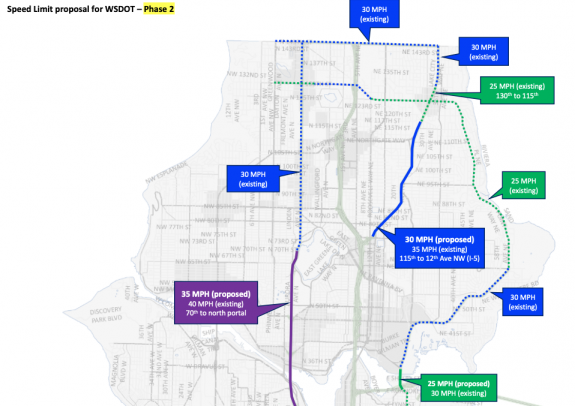
The remaining change south of downtown in phase 2 would be a reduction on East Marginal Way south of the 1st Ave S bridge in Georgetown from 45 to 35 mph. This is the segment where SDOT is currently planning to add a grade-separated segment of the Georgetown to South Park trail. A stretch of 1st Ave S over SR-509 in South Park without any sidewalks would drop to 30 mph.
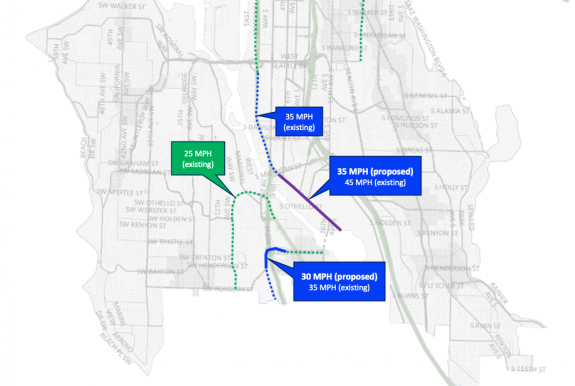
The chart below lays out the different limits proposed for each phase alongside the existing speed limit:
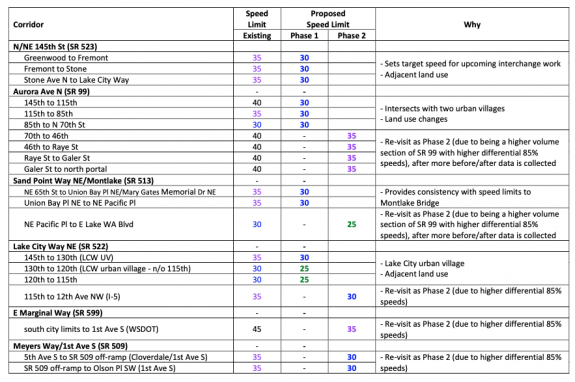
Speed limit changes alone aren’t enough to achieve all of our desired safety outcomes, but SDOT notes that “We’re seeing that speed limit signs alone can improve public safety, even without changes in enforcement or urban design. This finding is important because enforcement disproportionately impacts Black people and other people of color”. Increased police enforcement of speed limits doesn’t appear to be on the table here, rightfully.
The proposal includes data collected on vehicle speeds on these WSDOT corridors, including the difference between posted speed and the median speed (50th percentile), the speed at which half the drivers are driving below. Below are the WSDOT corridors with the biggest difference; most of the segments at the top of the list are proposed to see lower posted speeds in phase 2 as SDOT collects more “before/after” data. This list shows segments where the street design may be playing a larger role in current vehicle speeds than posted speed limit signs.
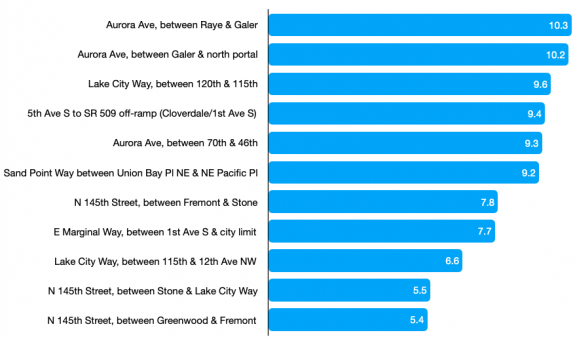
The proposal does list a few engineering strategies that SDOT is moving ahead with to pair with reduced speed limits, including traffic signal timing changes to reflect the new speed limits, as well as incorporating the new speed limits into any new project designs: design speeds can influence how lane lines are painted. But the primary one listed was increased signage: SDOT’s policy would add signs at every arterial crossing as well as every 1/4 mile: if a driver is going 25 mph they would encounter a speed limit sign every 36 seconds.
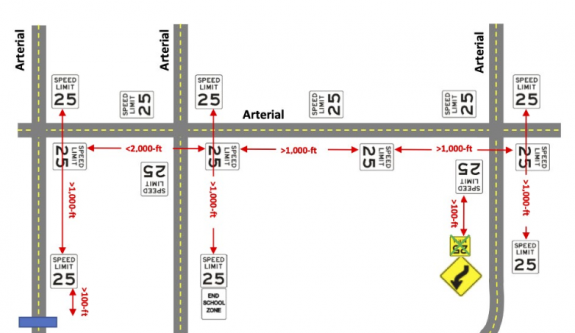
SDOT did not provide answers to questions from Seattle Bike Blog about any known current implementation schedule for this proposal or details about how the proposal was received at the Washington State Department of Transportation; we hope to update the post with more information as we get it. Update: SDOT’s Ethan Bergerson tells us that “we are planning for an initial reduction in speed limits on Aurora and other state routes in 2021. We must wait for the official approval from WSDOT, which is expected in the coming months. We will continue our partnership working towards lower speed limits into the future”.
Bergerson also told us, “Setting corridor speed limits is an important part of our larger Vision Zero strategy. Posting lower speed limits and more frequent signage follows NACTO best practices and has led to lower speeds and fewer crashes in other Seattle neighborhoods. These speed limit reductions open the door for further design changes described above and will be accompanied by signal timing changes and speed limits reductions occurring throughout Seattle. We expect this comprehensive approach to safety will influence driver behavior and lead to safer speeds.”
Initial data on Seattle’s first set of speed limit reductions, recorded before the pandemic caused traffic volumes to plummet, showed an overall reduction in crashes of 22%. These case studies were all on arterials in North Seattle, and none of them were high-crash corridors, but so far the data is promising. Implementing lower speed limits on the WSDOT-controlled corridors through the city will be key, though, and now we know just how far along the city is in proposing those changes.








Comments
19 responses to “Lower speed limits on state highways through city proposed by Seattle”
Generally seems like a great idea. My main concern is SR 99 from the north portal to Green Lake. I predict compliance near 0% if the limit is reduced without radically changing the design of the street. That’s already what’s happening on 15th between the Ballard Bridge and Dravus.
Great point. I think of four aspects to speed limits: the legal limit, the psychological limit (speed people actually drive), the natural limit (e.g., speed at which you fly off a curve), and the safety limit (speed at which “accidents” occur). The psychological limit is the driver, but it is affected by the others.
Initial data on Seattle’s first set of speed limit reductions, recorded before the pandemic caused traffic volumes to plummet, showed an overall reduction in crashes of 22%.
It’s good to know that we’re actually seeing a benefit from speed reductions, because it doesn’t appear that actual speeds have lowered (anecdotally), especially once people learned that enforcement is non-existent. The bigger question is if the benefits will continue as more people become complacent with lack of enforcement.
As a pedestrian crossing roads, the benefits from 25 mph speed limits have not been very apparent. Here in Ballard, try crossing 65th, 20th or 24th (Market is all signals in the core and 15th: fugeddaboutit!) at an intersection with no signal or crosswalk. You have to practically be in front of cars before they’ll slam on their brakes and even then, some will swerve around you at high speeds.
We need to figure out a way to enforce traffic laws in a non-discriminatory manner. It’s very possible, we just can’t be bothered to do so, so we just give up instead.
I’m shocked that the portion from W Green Lake Way to 70th St on Aurora isn’t in Phase 1 also.
Calming Sandpoint Way is outstanding; hopefully it will encourage faster triathletes and e-bikers to leave a crowded BGT and travel as traffic.
This may require a change to state law. State highway speed limits are partially set by the median travel speed, and they cannot be set more than a certain amount below that. This could require physical changes to slow vehicles. Time to reduce the Geo. Washington (99) bridge to 2 lanes each way.
As an occasional driver, I’d love speed limit to be lowered on Aurora bridge. The typical speed seems to be >45mph there, and I do not feel it safe enough. But it is hard to go slow where everyone else is going fast… And now just for consistency, I’d pull down the speed from Mercer all the way to Green laka.
One of the easiest road design changes to make to reduce speeds is reducing the number general traffic lanes by making curb lanes full-time bus lanes. All it takes is a few signs! Until you get into really fancy stuff like paint >.>
I would love for Aurora/99 to become 1 general-purpose lane, 1 bus lane, and a turn/exit/parking lane (depending on the specific location) in each direction. This would bring the infamous Bridge down from 6 to 5 total lanes (1 general-purpose through lane and 1 bus lane in each direction, plus exit lanes at each end). I would also love to see bus routes using the infamous tunnel so we can justify making a bus lane in the tunnel. (I mean, nothing’s stopping us from making a bus lane on a road no buses travel, but…)
Meanwhile, 15th could change so that there is a full-time bus lane *in addition* to a full-time turn/exit/parking lane. (It would take a bit of concrete to bring the bus stops out a lane, but as a temporary solution, the bus would have to pull in from the bus lane into the parking lane to reach stops).
Longer-term, 15th should have PBLs (I’m not sure whether one each side or a two-way path on the west side is better). I struggle a bit with seeing how bike lanes would work on Aurora, but no doubt there’s a way to do it well.
On a different note, the I-90 WB exit onto Rainier Ave NB is incredibly dangerous as there’s only a single sign informing drivers of the 25mph limit. I would like to see a meter-type traffic light on this exit to force drivers to slow down.
all of sandpoint way should be 25mph
The speed limit is a good change, but aurora feels so much safer once you cross 145th into shoreline. They installed sidewalks, the interurban trail provides grade separated crossings, etc.
It feels like an utterly abandoned portion of Seattle. So much could be done to make it better – I hope this is the first step and major design changes are pending.
Also, why aren’t there speeding cameras near the schools adjacent to Aurora?
“…enforcement disproportionately impacts Black people and other people of color”
Sounds like a good case for traffic cameras; otherwise, drivers will wise up to lax enforcement and those speed limit signs will be worthless.
25 and 30 mph is better but its still crazy fast…..I would like to see
all speed limits in Seattle no faster than 15mph including highway 99.
And the speed limit in residential areas absolutely no faster than
5 to 10mph…We need to slow down to save lives…
You guys are crazy. Cars and bicycles should go no faster than God intended us to go. 15mph max. Nobody needs to go faster than that.
I definitely agree that Aurora’s speed limit needs to be dropped substantially (30mph is better than nothing, but 25mph would be even better), but this change will now mean that Greenwood/Holman have a higher speed limit than a state highway, are just as unpleasant to be on for anyone not in a car (many parts of Greenwood north of 85th lack sidewalks still, and Holman’s sidewalks are unpleasantly narrow/overgrown), and have plenty of large apartment buildings and senior living facilities. Greenwood/Holman should be set at 25mph as well, with fully-connected sidewalks and bike lanes.
Correction – I was on the 5 a couple days ago, and it looked like Greenwood north of Holman had been changed to 30mph, and south of Holman is now 25mph. Of course the prevailing traffic flow appeared to be more like 35mph-40mph until about 85th, but progress?
This is a continuation of SDOT’s ignoring the will of the people. Fact that drivers ignore the SDOT limits shows the limits are set too low and people (90 % +) that drive consider the limits too low. All activities involve evaluation of risk/reward. Reasonable risk is unavoidable. The Vision 2030 is a thinly veiled plan to unreasonably penalize the 90 % plus of car traffic. SDOT can role out “Vision 2030” do what ever it wants to support it’s “We hate Cars” agenda. The truth is that motor vehicles are required for reasonable transportation in Seattle. SDOT’s speed limit restrictions do not pass the common sense test as illustrated by fact that 90 % + of drivers ignore them!
Do you really think that SDOT has a “We hate cars” agenda? Their transportation plans seem to be 90% focused on getting more cars on the road, moving more quickly. Quick movement through the city has more to do with throughput and flow of cars than it does of the actual speeds. I am pretty skeptical that tamping down on “race zones” like 15th and Aurora in the North End will actually slow down people’s trips. I’ve tried my usual routes at 25, and the timing is about the same. The real slowdown is poorly timed lights and lots of traffic.
You can post signs all day long and wrongfully claim they work solely by themselves. If you drove on those streets with lowered speed limits you would see they are being ignored. If the city truly was interested in this there would be design changes to the street and dare I say enforcement… This is not even a half-*** solution.
One undiscussed benefit of these changes would be less road noise. Which makes I-5 the elephant in the room. Why are speed limits on I-5 being ignored?
I think in general, traffic calming is a great idea, but at some point we’re going to have to talk about enforcement. Here in Ballard, we still have people racing down 15th at 45-50 mph between 85th and Market. Try driving that at the posted 30 sometime and you’ll be the target of massive road rage. My hope is that once the city gets past the “signage” phase, we can start working on enforcement.